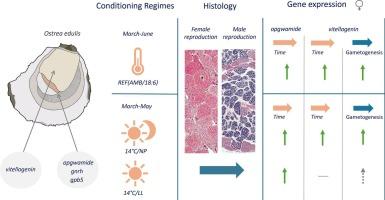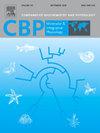常温、恒温及光周期条件下雌性欧洲平牡蛎生殖基因的表达。
IF 2.2
3区 生物学
Q4 BIOCHEMISTRY & MOLECULAR BIOLOGY
Comparative Biochemistry and Physiology A-Molecular & Integrative Physiology
Pub Date : 2025-09-25
DOI:10.1016/j.cbpa.2025.111934
引用次数: 0
摘要
欧洲平牡蛎(Ostrea edulis)是一种具有重要生态、商业和文化意义的物种。对扩大其生产的兴趣正在迅速增长,然而,在管理文化繁殖方面的挑战仍然存在。本研究旨在通过分析雌性亲鱼内脏神经节关键内分泌因子APGWamide、促性腺激素释放激素GnRH、GPB5以及性腺卵黄原蛋白的基因表达,提高对生殖控制的认识。这是在按性别和生殖阶段进行个体组织学分类的同时进行的。牡蛎受到三种不同的调节机制:一种是由环境温度和18 h光照:6 h黑暗(REF(Amb/18:6))组成的参考机制,另一种是在模拟自然光周期(14C/NP)或恒定24小时光照(14C/LL)下的14 °C恒温机制。组织学显示,在不同的政体中,女性向男性转变。在所有条件下配子发生均有进展,但恒定光照(14C/LL)下雌性配子发育不均匀。Apgwamide的表达随着雌性发育而显著增加。在REF(Amb/18:6)和14C/NP机制下,卵黄原蛋白的表达也随着时间的推移和配子发生而显著增加。虽然不能排除gnrh和gpb5在生殖中的作用,但在该数据集中没有观察到gnrh和gpb5表达的明确模式。总之,这些发现支持APGWamide和卵黄原蛋白是女性生殖中感兴趣的关键因素,光以及已知的温度影响发育。这项研究为支持亲鱼调节和欧洲平生牡蛎的生产和恢复工作提供了见解。本文章由计算机程序翻译,如有差异,请以英文原文为准。

Reproductive gene expression in female broodstock European flat oyster, Ostrea edulis, under ambient and constant temperature and photoperiod regimes
The European flat oyster (Ostrea edulis) is a species of significant ecological, commercial and cultural importance. Interest in scaling up its production is growing rapidly, however, challenges in managing reproduction in culture remain. This study aimed to improve understanding of reproductive control in female broodstock by analysing the gene expression of the key endocrine factors APGWamide, GnRH (gonadotropin releasing hormone) and GPB5 in the visceral ganglion, as well as vitellogenin in the gonads. This was performed alongside histological classification of individuals by sex and reproductive stage. Oysters were subjected to three different conditioning regimes: a reference regime consisting of ambient temperature and a long-day photoperiod of 18-h light: 6-h dark (REF(Amb/18:6)), and separately, two constant temperature regimes of 14 °C, either under simulated natural photoperiod (14C/NP) or constant 24-h light (14C/LL). Histology revealed a female-to-male shift across regimes. Gametogenesis progressed under all conditions, but females under constant light (14C/LL) showed less uniform development. Apgwamide expression significantly increased as females developed across all regimes. Vitellogenin expression also significantly increased over time and with gametogenesis under the REF(Amb/18:6) and 14C/NP regimes. No clear patterns were observed for gnrh and gpb5 expression in this dataset, though their roles in reproduction cannot be excluded. Altogether, these findings support APGWamide and vitellogenin as key factors of interest in female reproduction, with light, as well as the known effects of temperature, influencing development. This research provides insights to support broodstock conditioning and European flat oyster production and restoration efforts.
求助全文
通过发布文献求助,成功后即可免费获取论文全文。
去求助
来源期刊
CiteScore
5.00
自引率
4.30%
发文量
155
审稿时长
3 months
期刊介绍:
Part A: Molecular & Integrative Physiology of Comparative Biochemistry and Physiology. This journal covers molecular, cellular, integrative, and ecological physiology. Topics include bioenergetics, circulation, development, excretion, ion regulation, endocrinology, neurobiology, nutrition, respiration, and thermal biology. Study on regulatory mechanisms at any level of organization such as signal transduction and cellular interaction and control of behavior are also published.

 求助内容:
求助内容: 应助结果提醒方式:
应助结果提醒方式:


